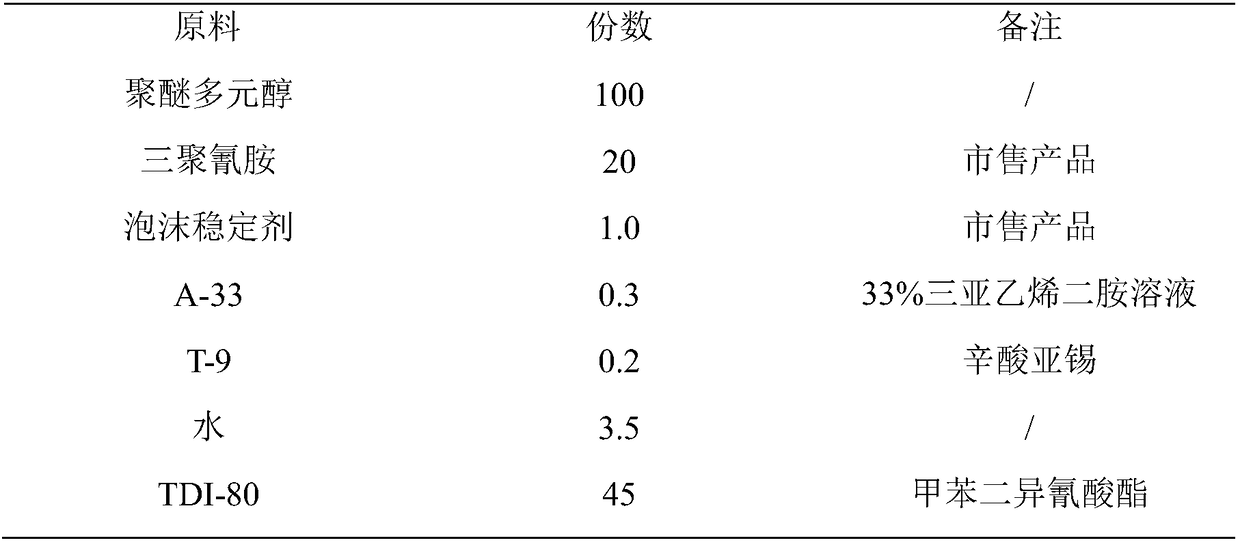Flame-resistant type polyether polyol for sponges and preparation method thereof
A polyether polyol and flame retardant technology, which is applied in the field of polyether polyol for flame retardant sponge and its preparation, can solve the problems of difficult industrialized production, limited flame retardant effect, long reaction period, etc., and can achieve formula adjustment Flexible and convenient, low production cost, simple and easy preparation method
- Summary
- Abstract
- Description
- Claims
- Application Information
AI Technical Summary
Problems solved by technology
Method used
Image
Examples
Embodiment 1
[0026] Add 250g of polyester 1000, 93g of trihydroxymethylphosphine oxide, and 0.06g of a modified bimetallic catalyst into the reactor at room temperature, and vacuum dehydrate at -0.093MPa and 110°C for 2 hours; add 52g of propylene oxide to induce the activation reaction, When the pressure in the reaction device continues to drop to negative pressure and the temperature continues to rise, it indicates that the polymerization reaction has started. Continuously feed 2432g of propylene oxide and 149g of ethylene oxide, and the reaction temperature is 140°C; after the feeding is completed, continue the aging reaction for 1h, and then Vacuum degassing at -0.093 MPa for 1 hour, cooling to 80°C, and discharging to obtain the target polyether polyol A. The specific test data are shown in Table 1.
Embodiment 2
[0028] Add 750g of polyester 1000, 31g of trihydroxymethylphosphine oxide, and 0.32g of a modified bimetallic catalyst into the reactor at room temperature, and vacuum dehydrate at -0.093MPa and 110°C for 1 hour; add 39g of propylene oxide to induce the activation reaction, When the pressure in the reaction device continues to drop to negative pressure and the temperature continues to rise, it indicates that the polymerization reaction has started. Continuously feed 2098g of propylene oxide and 324g of ethylene oxide, and the reaction temperature is 130°C; after the feeding is completed, continue the aging reaction for 0.5h. Then vacuum degassing at -0.093MPa for 2h, cooling down to 80°C, and discharging to obtain the target polyether polyol B. The specific test data are shown in Table 1.
Embodiment 3
[0030] Add 500g of polyester 1000, 62g of trihydroxymethylphosphine oxide, and 0.19g of modified bimetallic catalyst into the reactor at room temperature, and vacuum dehydrate at -0.093MPa and 110°C for 1.5h; add 56g of propylene oxide to induce activation reaction , when the pressure in the reaction device continues to drop to negative pressure and the temperature continues to rise, it indicates that the polymerization reaction has started. Continuously feed 2255g of propylene oxide and 233g of ethylene oxide, and the reaction temperature is 135°C; after the feeding is completed, continue the aging reaction for 1h. Then vacuum degassing at -0.093MPa for 1.5h, cooling down to 80°C, and discharging to obtain the target polyether polyol C. The specific test data are shown in Table 1.
PUM
| Property | Measurement | Unit |
|---|---|---|
| hydroxyl value | aaaaa | aaaaa |
| Functional group degree | aaaaa | aaaaa |
Abstract
Description
Claims
Application Information
 Login to View More
Login to View More - R&D
- Intellectual Property
- Life Sciences
- Materials
- Tech Scout
- Unparalleled Data Quality
- Higher Quality Content
- 60% Fewer Hallucinations
Browse by: Latest US Patents, China's latest patents, Technical Efficacy Thesaurus, Application Domain, Technology Topic, Popular Technical Reports.
© 2025 PatSnap. All rights reserved.Legal|Privacy policy|Modern Slavery Act Transparency Statement|Sitemap|About US| Contact US: help@patsnap.com


